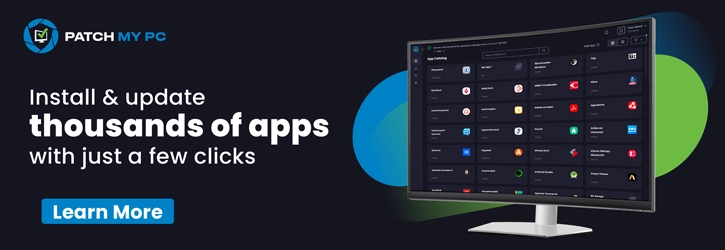Hi, today we are discussing Do Not Show Feedback Notifications Policy Using Intune Setting Catalog. As you all know that Microsoft Intune is a cloud solution that helps the IT admin to manage and deploy policy for organizations in effective manner.
With the setting catalog providing different type of policies that are very effective for organizations. We know that what is a feedback notification in system right, it acts as a message or notifications it usually asking for the response from the user about their service or product.
We know that it is very important for the company to understand what the users feel for those product or features. But sometimes, The Do Not Show Feedback Notifications Policy keeps users focused by reducing feedback interruptions. It improves user experience, prevents notification interruption, and provides more control.
By minimizing distractions and protecting privacy, it ensures a smoother digital experience. the user can disable the policy and Feedback notifications are not completely disabled and they may still appear depending on settings Feedback notifications are not completely disabled and they may still appear depending on settings.
Table of Contents
What Happens When the Policy Setting for Feedback Notifications is Enabled?
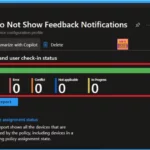
If you enable this policy setting, users will no longer see feedback notifications through the Windows Feedback app.
What if the Policy Setting is Disabled or not Configured?
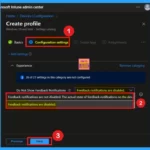
If the policy is disabled or left unconfigured, users may receive notifications from the Windows Feedback app requesting feedback.
Do Not Show Feedback Notifications Policy – CSP Details
Above we discussed a lot of things about Do does not show feedback notification policy and its benefits. When we discuss this policy, we have to know about its CSP details. Configuration Service Providers (CSPs) enable Intune to manage Windows device settings by allowing remote configuration changes through the Windows Registry.
- The following section highlights the CSP details of the Do Not Show Feedback Notifications Policy found under the Experience category.
| Property name | Property value |
|---|---|
| Format | int |
| Access Type | Add, Delete, Get, Replace |
| Default Value | 0 |

- How to Configure Do not Add Shares of Recently Opened Documents to Network Locations Policy using Intune
- Enable Sync My Settings Policy on Intune Settings Catalog
- Easy Way to Set Bandwidth Throttling End Time using Setting Catalog Via Intune
Create Profile
To deploy a policy in Intune, start by logging into the Microsoft Intune admin center. Navigate to Devices > Configuration profiles > Create profile. Then, click “Create” to begin setting up a new policy. In the “New Policy” section, select the platform as Windows 10 and later and choose the profile type as Settings Catalog.
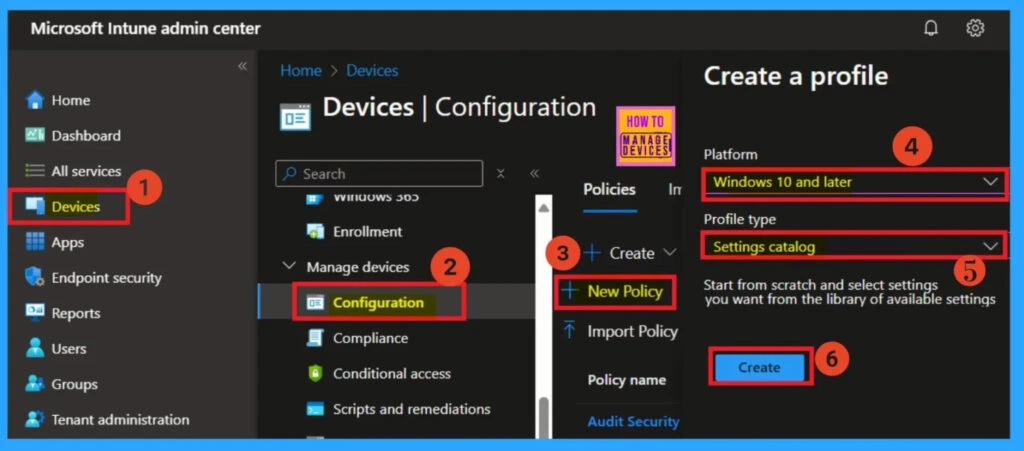
Basics
Basic is the first section to complete when creating a policy. Begin by entering the essential information, including the policy name (required), a description for future reference, and selecting the appropriate platform. Once done, click Next to proceed.

Configuration Setting- Settings Picker
Following the Basics section, you must configure the policy’s actual settings. Click +Add settings to select the desired options. When you click on +Add settings option, a Settings Picker window will appear. Here you have to find and select the Experiance option. In the experiance option select the Do Not Show Feedback Notifications Policy.
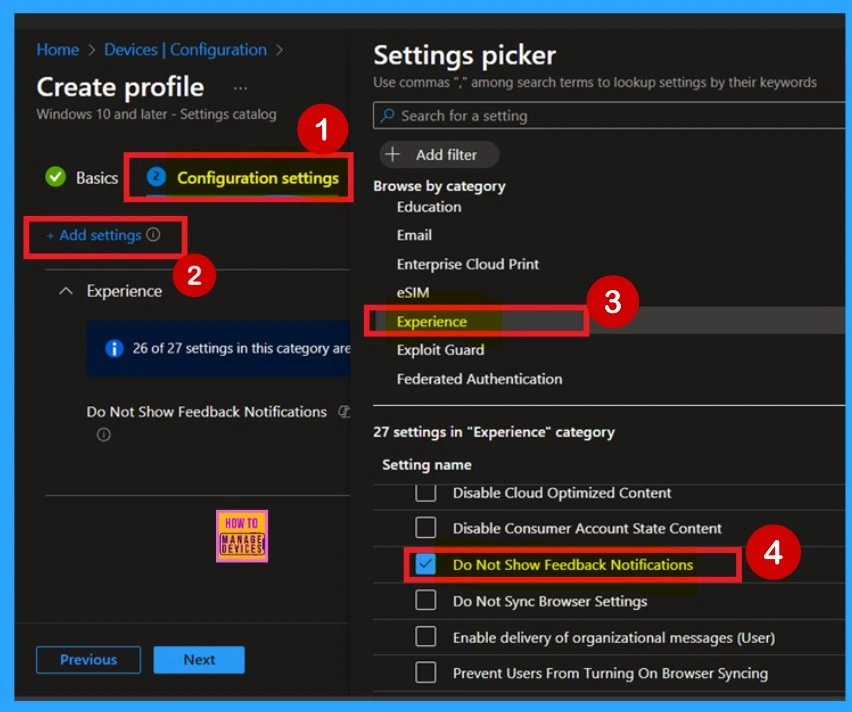
After selecting the configuration settings now, you can close the settings Picker window here you can see that the Do not show feedback notification settings are shown into the screen. Here 2 options are available such as, ”Feedback notifications are not disabled the actual state of feedback notifications on the device will then depend on what GP has configured or what the user has configured locally” and Feedback notifications are disabled.
- The policy is Defaulted set as Feedback notifications are not disabled the actual state of feedback notifications on the device will then depend on what GP has configured or what the user has configured locally.
- I selected the Feedback notifications are disabled option.
| Policy Options | Info |
|---|---|
| Feedback notifications are not disabled the actual state of feedback notifications on the device will then depend on what GP has configured or what the user has configured locally. | Feedback notifications may still appear based on Group Policy settings or user preferences. Their visibility depends on both configurations. |
| Feedback notifications are disabled. | If you disable or don’t configure this policy setting, users may see notifications through the Windows Feedback app asking users for feedback. |
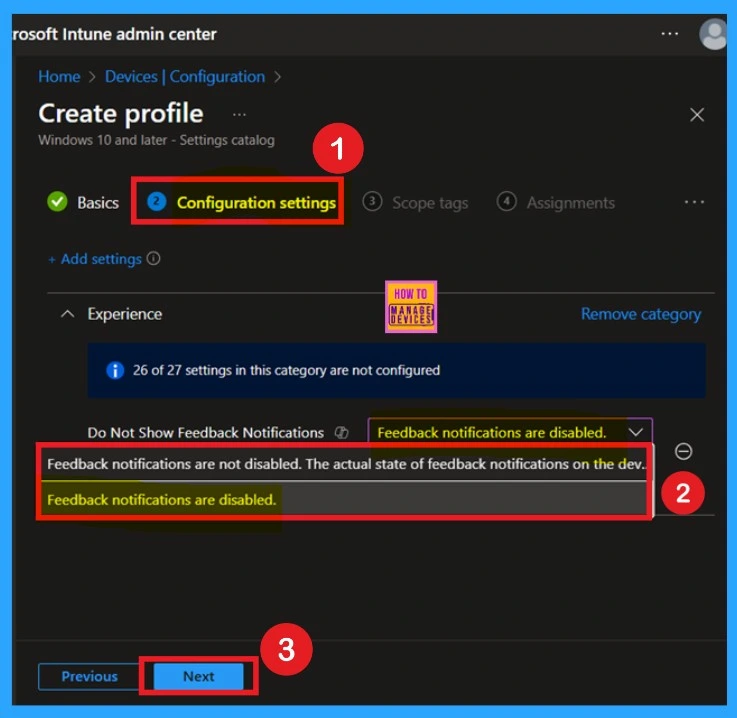
Scope Tags
In Intune, the Scope Tags feature helps to manage policy access. By assigning tags, you can define which users or groups can view and apply certain policies, often based on factors such as team, role, or region. Although scope tags enhance organization and access control, they’re not required. You can move forward by selecting Next without adding any.
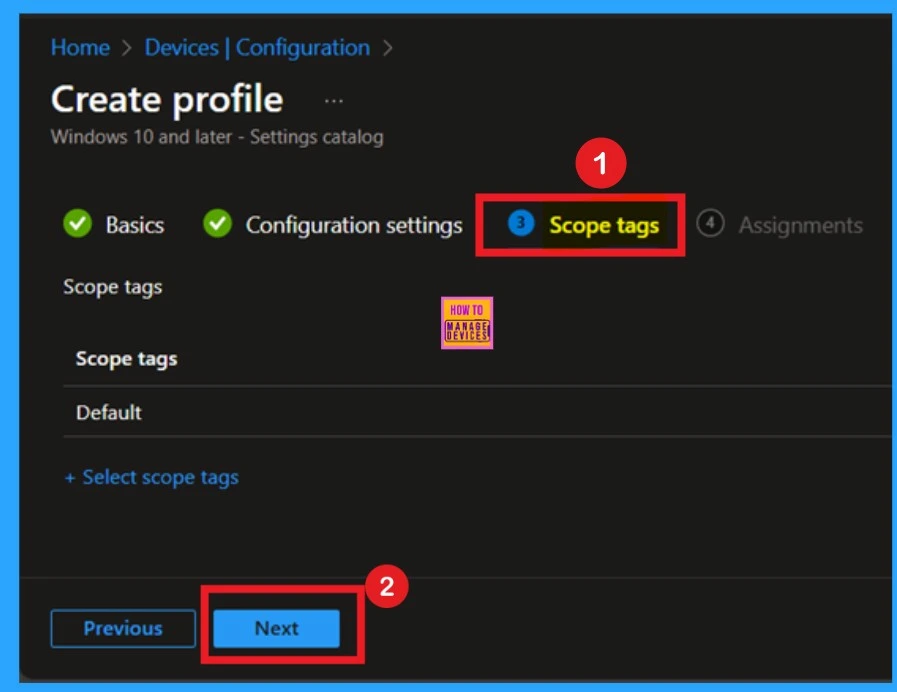
Assignments
The next step is the Assignments tab, which is crucial for deploying the policy. In this section, you’ll specify the group that the policy should apply to. Start by clicking Add Groups under the Include Groups section. A list of available groups will be displayed. Select the one you want to assign the policy to.
After making your selection, the group will be added to the list of assignments. Once you’ve reviewed and confirmed your selections, click Next to proceed.
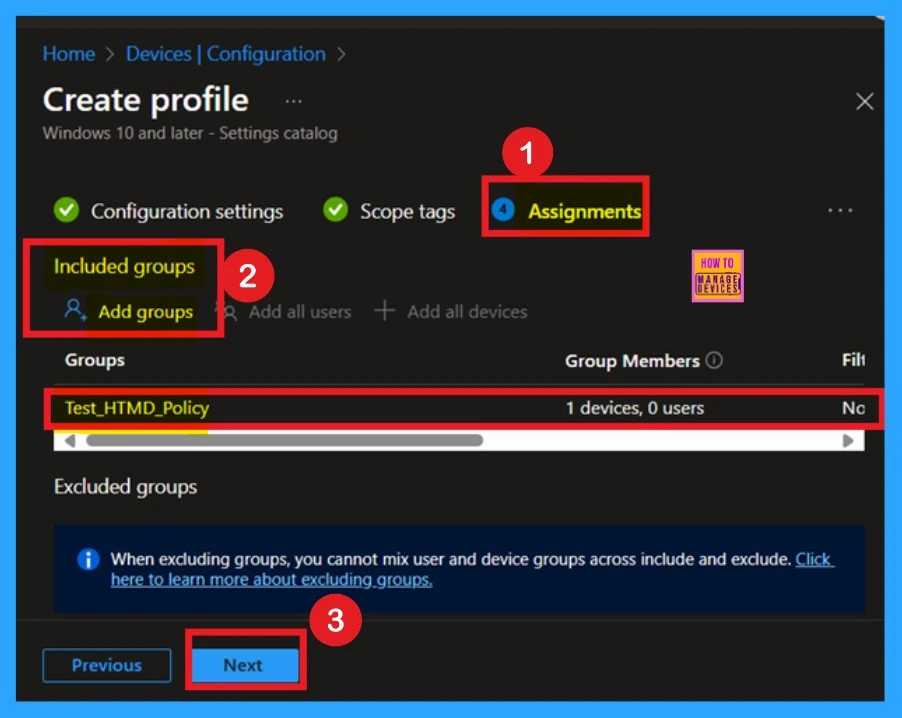
Review+create
Once you’ve finished the assignments, you’ll reach the Review + Create stage this is the final step in configuring your policy. Here, you can double-check all the settings, including the basic information and configuration details. If everything appears correct, click Create to complete the process and deploy the policy.
- A confirmation message (Notification) will appear, letting you know the policy has been successfully created.
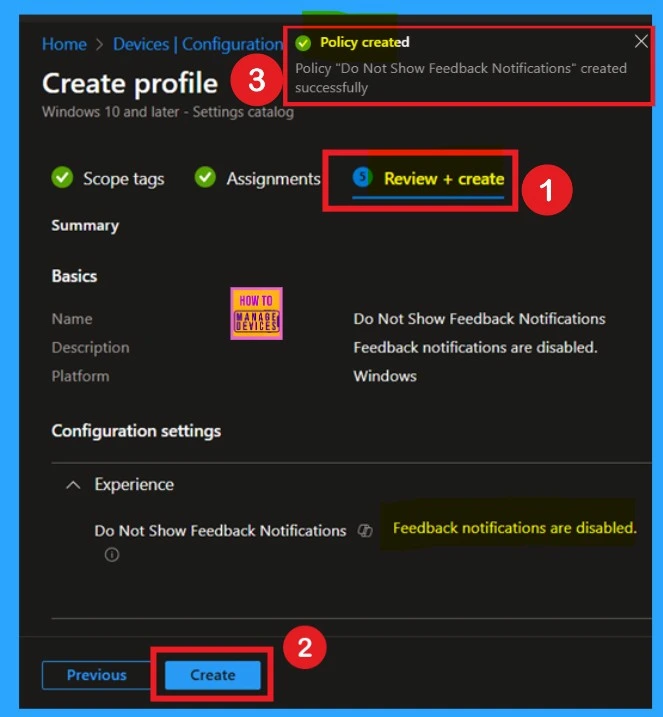
Monitoring Status
When you set up a new policy for a device, it usually takes up to 8 hours for it to be applied automatically. To speed things up, you can manually sync with the help of Company Portal. Once the sync is complete, you can check if the policy was successfully applied by going to Intune:
Navigate to Devices > Configuration profiles, then choose the specific policy to review its deployment status.
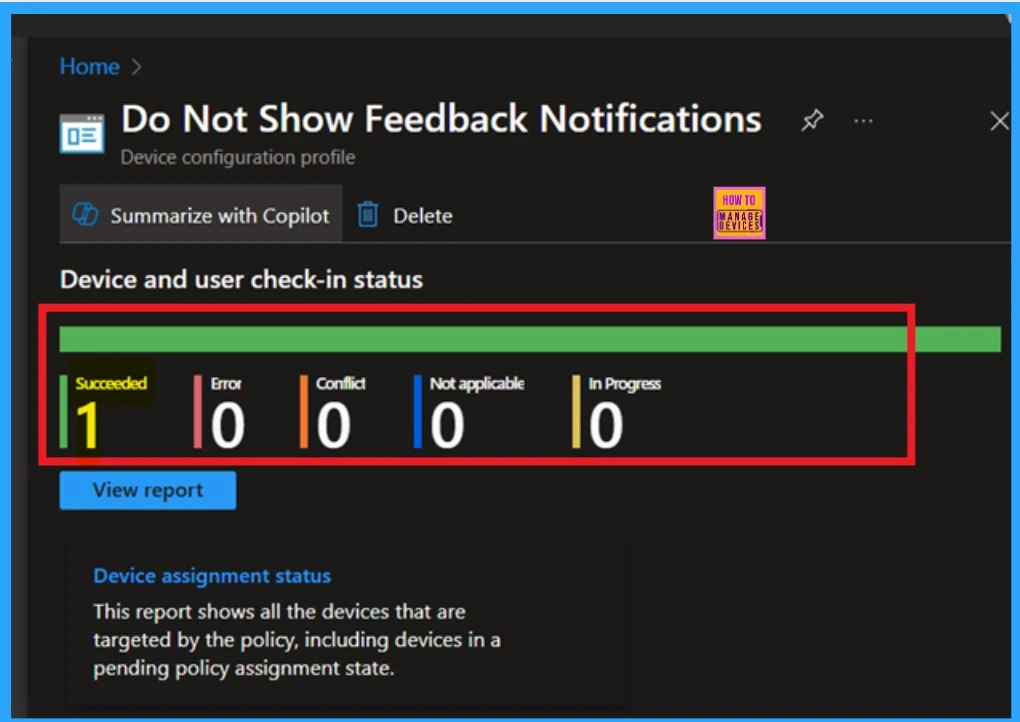
Client-Side Verification
To get the client-side verification, open the Event Viewer and navigate to Applications and Services Logs > Microsoft > Windows > Device Management > Enterprise Diagnostic Provider > Admin. Once there, you can search for specific policy results by using the Filter Current Log feature located in the right pane. This helps quickly get the relevant results within the log.
- You have to concentrate on the 813 or 814 event ID to get the results.
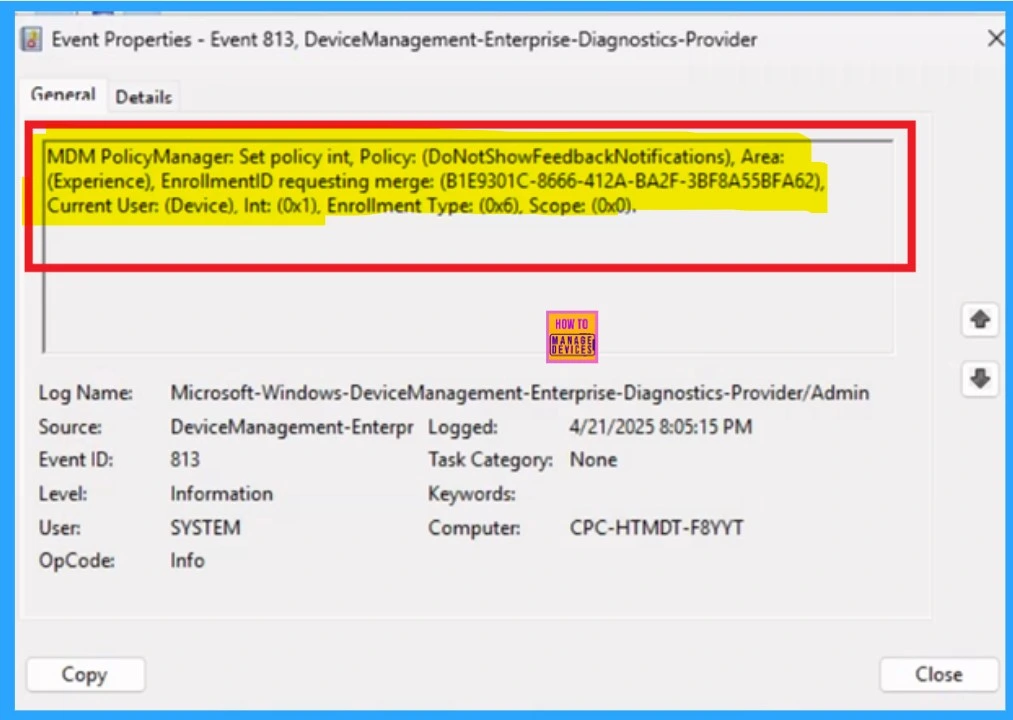
Need Further Assistance or Have Technical Questions?
Join the LinkedIn Page and Telegram group to get the latest step-by-step guides and news updates. Join our Meetup Page to participate in User group meetings. Also, Join the WhatsApp Community to get the latest news on Microsoft Technologies. We are there on Reddit as well.
Author
Anoop C Nair has been a Microsoft MVP for 10 consecutive years from 2015 onwards. He is a Workplace Solution Architect with more than 22+ years of experience in Workplace technologies. He is a Blogger, Speaker, and Local User Group Community leader. His primary focus is on Device Management technologies like SCCM and Intune. He writes about technologies like Intune, SCCM, Windows, Cloud PC, Windows, Entra, Microsoft Security, Career, etc.
